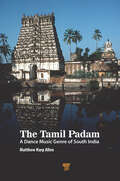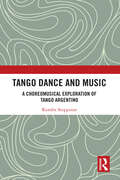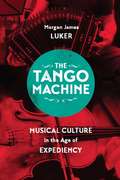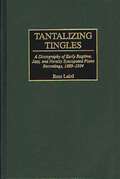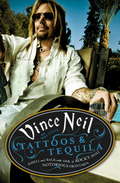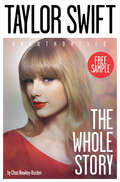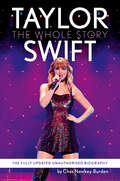- Table View
- List View
Tallinn '67 Jazz Festival: Myths and Memories
by Heli ReimannTallinn ’67 Jazz Festival: Myths and Memories explores the legendary 1967 jazz gathering that centered Tallinn, Estonia as the jazz capital of the USSR and marked both the pinnacle of a Soviet jazz awakening as well as the end of a long series of evolutionary jazz festivals in Estonia. This study offers new insights into what was the largest Soviet jazz festival of its time through an abundance of collected materials – including thousands of pages of archival documents, more than a hundred hours of interviews and countless media reviews and photographs – while grappling with the constellation of myths integral to jazz discourse in an attempt to illuminate ‘how it really was’. Accounts from musicians, jazz fans, organisers and listeners bring renewed life to this transcultural event from more than half a century ago, framed by scholarly discussions contextualizing the festival within the closed conditions of the Cold War. Tallinn ’67 Jazz Festival details the lasting international importance of this confluence of Estonian, Soviet and American jazz and the ripple effects it spread throughout the world.
Tallis (Master Musicians Series)
by Kerry McCarthyThe composer Thomas Tallis (c. 1505 - November 1585) lived and worked through much of the turbulent Tudor period in England. Unlike many of his contemporaries, he did not just react to radical change: he thrived on it. He helped invent new musical styles to meet the demands of the English Reformation. He revived and reimagined older musical forms for a new era. Fewer than a hundred of his works have survived, but they are incredibly diverse, from miniature settings of psalms and hymns to a monumental forty-voice motet. In this new biography, author Kerry McCarthy traces Tallis's long career from his youthful appointment at Dover Priory to his years as a senior member of the Chapel Royal, revisiting the most important documents of his life and a wide variety of his musical works. The book also takes readers on a guided journey along the River Thames to the palaces, castles, and houses where Tallis made music for the four monarchs he served. It ends with reflections on Tallis's will, his epitaph (whose complete text McCarthy has recently rediscovered), and other postmortem remembrances that give us a glimpse of his significant place in the sixteenth-century musical world. Tallis will be treasured by performers, scholars, Tudor enthusiasts, and anyone interested in English Renaissance music.
Tallis (Master Musicians Series)
by Kerry McCarthyThe composer Thomas Tallis (c. 1505 - November 1585) lived and worked through much of the turbulent Tudor period in England. Unlike many of his contemporaries, he did not just react to radical change: he thrived on it. He helped invent new musical styles to meet the demands of the English Reformation. He revived and reimagined older musical forms for a new era. Fewer than a hundred of his works have survived, but they are incredibly diverse, from miniature settings of psalms and hymns to a monumental forty-voice motet. In this new biography, author Kerry McCarthy traces Tallis's long career from his youthful appointment at Dover Priory to his years as a senior member of the Chapel Royal, revisiting the most important documents of his life and a wide variety of his musical works. The book also takes readers on a guided journey along the River Thames to the palaces, castles, and houses where Tallis made music for the four monarchs he served. It ends with reflections on Tallis's will, his epitaph (whose complete text McCarthy has recently rediscovered), and other postmortem remembrances that give us a glimpse of his significant place in the sixteenth-century musical world. Tallis will be treasured by performers, scholars, Tudor enthusiasts, and anyone interested in English Renaissance music.
The Tamil Padam: A Dance Music Genre of South India
by Matthew Harp AllenThis book is a study of the Bharata Natyam dance genre "padam" focusing on its patrons and composers and its formal structure, texts, and music. It examines the "rewriting" of South Indian dance and the decades-long debates over the classicization and ownership of South Indian music. The control over the representation of the arts is a subject that should resonate with scholars working in a wide variety of genres and across many countries. The study is diachronic (historical) and also synchronic (examining padams’ organizational structure as a system). Importantly, the text includes 30 Tamil language songs, minutely translated and annotated together with a documentation of their performance history in the 20th century. Classical and modern music composers and performers, ethnomusicologists, librettists, singers, choreographers, art historians, dancers, dance scholars, and dance teachers will find them useful in giving students a deep contextual understanding of Bharata Natyam. The book will find an enthusiastic readership with dance teachers who are actively training Bharata Natyam students. It will also attract a scholarly audience as an anthropological and historical study of an artistic form which has a high profile in South Asia and has become prominent in the growing fields of ethnomusicology, dance ethnography and "world dance."
The Tamil Padam: A Dance Music Genre of South India
by Matthew Harp AllenThis book is a study of the Bharata Natyam dance genre "padam" focusing on its patrons and composers and its formal structure, texts, and music. It examines the "rewriting" of South Indian dance and the decades-long debates over the classicization and ownership of South Indian music. The control over the representation of the arts is a subject that should resonate with scholars working in a wide variety of genres and across many countries. The study is diachronic (historical) and also synchronic (examining padams’ organizational structure as a system). Importantly, the text includes 30 Tamil language songs, minutely translated and annotated together with a documentation of their performance history in the 20th century. Classical and modern music composers and performers, ethnomusicologists, librettists, singers, choreographers, art historians, dancers, dance scholars, and dance teachers will find them useful in giving students a deep contextual understanding of Bharata Natyam. The book will find an enthusiastic readership with dance teachers who are actively training Bharata Natyam students. It will also attract a scholarly audience as an anthropological and historical study of an artistic form which has a high profile in South Asia and has become prominent in the growing fields of ethnomusicology, dance ethnography and "world dance."
The Tangible in Music: The Tactile Learning of a Musical Instrument (SEMPRE Studies in The Psychology of Music)
by Marko AhoIn the age of digital music it seems striking that so many of us still want to produce music concretely with our bodies, through the movement of our limbs, lungs and fingers, in contact with those materials and objects which are capable of producing sounds. The huge sales figures of musical instruments in the global market, and the amount of time and effort people of all ages invest in mastering the tools of music, make it clear that playing musical instruments is an important phenomenon in human life. By combining the findings made in music psychology and performative ethnomusicology, Marko Aho shows how playing a musical instrument, and the pleasure musicians get from it, emerges from an intimate dialogue between the personally felt body and the sounding instrument. An introduction to the general aspects of the tactile resources of musical instruments, musical style and the musician is followed by an analysis of the learning process of the regional kantele style of the Perho river valley in Finnish Central Ostrobothnia.
The Tangible in Music: The Tactile Learning of a Musical Instrument (SEMPRE Studies in The Psychology of Music)
by Marko AhoIn the age of digital music it seems striking that so many of us still want to produce music concretely with our bodies, through the movement of our limbs, lungs and fingers, in contact with those materials and objects which are capable of producing sounds. The huge sales figures of musical instruments in the global market, and the amount of time and effort people of all ages invest in mastering the tools of music, make it clear that playing musical instruments is an important phenomenon in human life. By combining the findings made in music psychology and performative ethnomusicology, Marko Aho shows how playing a musical instrument, and the pleasure musicians get from it, emerges from an intimate dialogue between the personally felt body and the sounding instrument. An introduction to the general aspects of the tactile resources of musical instruments, musical style and the musician is followed by an analysis of the learning process of the regional kantele style of the Perho river valley in Finnish Central Ostrobothnia.
Tango Dance and Music: A Choreomusical Exploration of Tango Argentino
by Kendra StepputatThis book investigates choreomusical aspects of tango argentino in translocal practice, in particular its current manifestation in Europe. It looks at translocal tango argentino in its many facets: movement structures, sound structures, dancers and musicians, and the complex relations between these factors that all have their share in shaping the practice. Beyond being the first extensive monograph about translocal tango music and dance, the book crosses borders in the use of both qualitative and quantitative methods, ranging from participant observation to statistical data evaluation, including optical motion capture for movement analysis. The book contains a brief historical overview of tango argentino practice in the twentieth century, bringing together the development of music and dance in a holistic way to better understand the background of the current interconnectedness. The first main part of the book focuses on the “danceability” aspect of tango music. The exploration is based on tango DJs’, tango dance teachers’, and tango musicians’ view of tango danceability as well as experimental approaches. The second part is dedicated to tango dance and its “musicality”. It investigates with quantitative and qualitative methods tango movement repertoire and principles and how these relate to tango musical features.
Tango Dance and Music: A Choreomusical Exploration of Tango Argentino
by Kendra StepputatThis book investigates choreomusical aspects of tango argentino in translocal practice, in particular its current manifestation in Europe. It looks at translocal tango argentino in its many facets: movement structures, sound structures, dancers and musicians, and the complex relations between these factors that all have their share in shaping the practice. Beyond being the first extensive monograph about translocal tango music and dance, the book crosses borders in the use of both qualitative and quantitative methods, ranging from participant observation to statistical data evaluation, including optical motion capture for movement analysis. The book contains a brief historical overview of tango argentino practice in the twentieth century, bringing together the development of music and dance in a holistic way to better understand the background of the current interconnectedness. The first main part of the book focuses on the “danceability” aspect of tango music. The exploration is based on tango DJs’, tango dance teachers’, and tango musicians’ view of tango danceability as well as experimental approaches. The second part is dedicated to tango dance and its “musicality”. It investigates with quantitative and qualitative methods tango movement repertoire and principles and how these relate to tango musical features.
The Tango Machine: Musical Culture in the Age of Expediency (Chicago Studies in Ethnomusicology)
by Morgan James LukerIn Argentina, tango isn’t just the national music—it’s a national brand. But ask any contemporary Argentine if they ever really listen to it and chances are the answer is no: tango hasn’t been popular for more than fifty years. In this book, Morgan James Luker explores that odd paradox by tracing the many ways Argentina draws upon tango as a resource for a wide array of economic, social, and cultural—that is to say, non-musical—projects. In doing so, he illuminates new facets of all musical culture in an age of expediency when the value and meaning of the arts is less about the arts themselves and more about how they can be used. Luker traces the diverse and often contradictory ways tango is used in Argentina in activities ranging from state cultural policy-making to its export abroad as a cultural emblem, from the expanding nonprofit arts sector to tango-themed urban renewal projects. He shows how projects such as these are not peripheral to an otherwise “real” tango—they are the absolutely central means by which the values of this musical culture are cultivated. By richly detailing the interdependence of aesthetic value and the regimes of cultural management, this book sheds light on core conceptual challenges facing critical music scholarship today.
The Tango Machine: Musical Culture in the Age of Expediency (Chicago Studies in Ethnomusicology)
by Morgan James LukerIn Argentina, tango isn’t just the national music—it’s a national brand. But ask any contemporary Argentine if they ever really listen to it and chances are the answer is no: tango hasn’t been popular for more than fifty years. In this book, Morgan James Luker explores that odd paradox by tracing the many ways Argentina draws upon tango as a resource for a wide array of economic, social, and cultural—that is to say, non-musical—projects. In doing so, he illuminates new facets of all musical culture in an age of expediency when the value and meaning of the arts is less about the arts themselves and more about how they can be used. Luker traces the diverse and often contradictory ways tango is used in Argentina in activities ranging from state cultural policy-making to its export abroad as a cultural emblem, from the expanding nonprofit arts sector to tango-themed urban renewal projects. He shows how projects such as these are not peripheral to an otherwise “real” tango—they are the absolutely central means by which the values of this musical culture are cultivated. By richly detailing the interdependence of aesthetic value and the regimes of cultural management, this book sheds light on core conceptual challenges facing critical music scholarship today.
The Tango Machine: Musical Culture in the Age of Expediency (Chicago Studies in Ethnomusicology)
by Morgan James LukerIn Argentina, tango isn’t just the national music—it’s a national brand. But ask any contemporary Argentine if they ever really listen to it and chances are the answer is no: tango hasn’t been popular for more than fifty years. In this book, Morgan James Luker explores that odd paradox by tracing the many ways Argentina draws upon tango as a resource for a wide array of economic, social, and cultural—that is to say, non-musical—projects. In doing so, he illuminates new facets of all musical culture in an age of expediency when the value and meaning of the arts is less about the arts themselves and more about how they can be used. Luker traces the diverse and often contradictory ways tango is used in Argentina in activities ranging from state cultural policy-making to its export abroad as a cultural emblem, from the expanding nonprofit arts sector to tango-themed urban renewal projects. He shows how projects such as these are not peripheral to an otherwise “real” tango—they are the absolutely central means by which the values of this musical culture are cultivated. By richly detailing the interdependence of aesthetic value and the regimes of cultural management, this book sheds light on core conceptual challenges facing critical music scholarship today.
The Tango Machine: Musical Culture in the Age of Expediency (Chicago Studies in Ethnomusicology)
by Morgan James LukerIn Argentina, tango isn’t just the national music—it’s a national brand. But ask any contemporary Argentine if they ever really listen to it and chances are the answer is no: tango hasn’t been popular for more than fifty years. In this book, Morgan James Luker explores that odd paradox by tracing the many ways Argentina draws upon tango as a resource for a wide array of economic, social, and cultural—that is to say, non-musical—projects. In doing so, he illuminates new facets of all musical culture in an age of expediency when the value and meaning of the arts is less about the arts themselves and more about how they can be used. Luker traces the diverse and often contradictory ways tango is used in Argentina in activities ranging from state cultural policy-making to its export abroad as a cultural emblem, from the expanding nonprofit arts sector to tango-themed urban renewal projects. He shows how projects such as these are not peripheral to an otherwise “real” tango—they are the absolutely central means by which the values of this musical culture are cultivated. By richly detailing the interdependence of aesthetic value and the regimes of cultural management, this book sheds light on core conceptual challenges facing critical music scholarship today.
The Tango Machine: Musical Culture in the Age of Expediency (Chicago Studies in Ethnomusicology)
by Morgan James LukerIn Argentina, tango isn’t just the national music—it’s a national brand. But ask any contemporary Argentine if they ever really listen to it and chances are the answer is no: tango hasn’t been popular for more than fifty years. In this book, Morgan James Luker explores that odd paradox by tracing the many ways Argentina draws upon tango as a resource for a wide array of economic, social, and cultural—that is to say, non-musical—projects. In doing so, he illuminates new facets of all musical culture in an age of expediency when the value and meaning of the arts is less about the arts themselves and more about how they can be used. Luker traces the diverse and often contradictory ways tango is used in Argentina in activities ranging from state cultural policy-making to its export abroad as a cultural emblem, from the expanding nonprofit arts sector to tango-themed urban renewal projects. He shows how projects such as these are not peripheral to an otherwise “real” tango—they are the absolutely central means by which the values of this musical culture are cultivated. By richly detailing the interdependence of aesthetic value and the regimes of cultural management, this book sheds light on core conceptual challenges facing critical music scholarship today.
The Tango Machine: Musical Culture in the Age of Expediency (Chicago Studies in Ethnomusicology)
by Morgan James LukerIn Argentina, tango isn’t just the national music—it’s a national brand. But ask any contemporary Argentine if they ever really listen to it and chances are the answer is no: tango hasn’t been popular for more than fifty years. In this book, Morgan James Luker explores that odd paradox by tracing the many ways Argentina draws upon tango as a resource for a wide array of economic, social, and cultural—that is to say, non-musical—projects. In doing so, he illuminates new facets of all musical culture in an age of expediency when the value and meaning of the arts is less about the arts themselves and more about how they can be used. Luker traces the diverse and often contradictory ways tango is used in Argentina in activities ranging from state cultural policy-making to its export abroad as a cultural emblem, from the expanding nonprofit arts sector to tango-themed urban renewal projects. He shows how projects such as these are not peripheral to an otherwise “real” tango—they are the absolutely central means by which the values of this musical culture are cultivated. By richly detailing the interdependence of aesthetic value and the regimes of cultural management, this book sheds light on core conceptual challenges facing critical music scholarship today.
Tantalizing Tingles: A Discography of Early Ragtime, Jazz, and Novelty Syncopated Piano Recordings, 1889-1934 (Discographies: Association for Recorded Sound Collections Discographic Reference)
by Ross LairdFor the first time, all data for recordings of non-classical piano made for issue on disc and cylinder records prior to 1935 are brought together in this work. The majority of the listing consists of material which has never been published in any form. The volume includes piano solos, duets, trios, and quartets, as well as selected titles where a soloist is featured within a recording by a dance band or orchestra. It covers a wide variety of pianists and piano styles including ragtime, stride, novelty-syncopated, boogie, and blues. This work will be of interest to major libraries, archives, and schools of music, as well as researchers and collectors.The recordings covered in this work range from the earliest known piano recordings which were made in 1889 as cylinder records for the North American Phonograph Company through recordings of the early 1930s by some of the great jazz pianists of that era (Mary Lou Williams, Garland Wilson, Herman Chittison, Art Tatum, and Teddy Wilson). In between are a wide variety of pianists and piano styles from around the world. While many of the solos recorded were of popular tunes of the day, there is also a fascinating selection of piano compositions, often played by the composer. They include such well-known names as Felix Arndt, Nacio Herb Brown, Hoagy Carmichael, Rudolf Friml, George Gershwin, John W. Green, Ferdie Grofe, Ralph Rainger, Leslie Stuart, Clarence Williams, and Vincent Youmans. A comprehensive title index includes composer credits for the majority of titles listed.
Tanzmusik in der DDR: Dresdner Musiker zwischen Kulturpolitik und internationalem Musikmarkt, 1945-1961 (Musik und Klangkultur #31)
by Simon BretschneiderIn der frühen DDR changierte Tanz- und Unterhaltungsmusik zwischen Schlager, Swing und Rock 'n' Roll. Gleichzeitig verfolgten Partei und Staat die kulturpolitische Strategie, internationalen Musiktrends eine sozialistische, nationale Alternative gegenüberzustellen. Simon Bretschneider analysiert sowohl die bürgerliche Prägung und permanente Westorientierung dieses Diskurses wie auch die Versuche der Musikkapellen und Fans, die staatlich gesetzten Zwänge zu boykottieren. Am Beispiel der Stadt Dresden zeigt er, was für den gesamten Osten Deutschlands in den 1950ern zutreffen dürfte: Gegen den internationalen Musikmarkt hatte auch diktatorische Politik keine Chance.
Tarnished Gold: Record Industry Revisited
by R. Serge DenisoffThe great depression in the popular recording industry that began in 1979 still continues. There are signs, however, that the industry is adjusting to new technologies and may soon revive. R. Serge Denisoff documents the decline and possible revival of this comprehensive study of the recording business, a sequel to his widely acclaimed Solid Gold: The Popular Record Industry. Denisoff offers a brief history of popular music and then, in detail, traces the life cycle of a record, beginning with the artist in the studio and following the record until its purchase. He explains the relationships between artist, manager, producer, company, distributor, merchandiser, and media. They all play roles in the scenario of a hit record. He also discusses the new technologies and how they may affect record sales, especially round-the-clock rock and roll on cable television. Tarnished Gold joins Solid Gold as a staple in the popular culture literature.
Tarnished Gold: Record Industry Revisited
by R. Serge DenisoffThe great depression in the popular recording industry that began in 1979 still continues. There are signs, however, that the industry is adjusting to new technologies and may soon revive. R. Serge Denisoff documents the decline and possible revival of this comprehensive study of the recording business, a sequel to his widely acclaimed Solid Gold: The Popular Record Industry. Denisoff offers a brief history of popular music and then, in detail, traces the life cycle of a record, beginning with the artist in the studio and following the record until its purchase. He explains the relationships between artist, manager, producer, company, distributor, merchandiser, and media. They all play roles in the scenario of a hit record. He also discusses the new technologies and how they may affect record sales, especially round-the-clock rock and roll on cable television. Tarnished Gold joins Solid Gold as a staple in the popular culture literature.
The Tastemaker: My Life with the Legends and Geniuses of Rock Music
by Tony KingThe Tastemaker charts the singular life of a man who has been at the beating heart of music's most iconic moments for over sixty years and features stories of his time working with everyone from the Beatles to the Ronettes and Elton John to the Rolling Stones. 'This is a brilliant book by a brilliant man. A magician with perfect taste. Thank God I met him. He is gold dust!'ELTON JOHNLeaving school at the age of sixteen to start his career in the music industry at Decca Records, Tony King would soon find himself becoming a close friend and confidante to some of the world's biggest artists - a far cry from his childhood days in Eastbourne. Living in an era of seismic social, technological and cultural transformation, King experienced these defining moments as an influential figure in London and New York's gay scenes. Despite his heady life in showbusiness, however, he would soon learn that a glittering career couldn't shield him from heartbreak - witness to the AIDS crisis and the devastating consequences, his personal life was intermittently marked by tumult and turmoil. This included spending time with with his friend Freddie Mercury in the Queen frontman's final days.Suffused with Tony King's disarming warmth and unparalleled charisma - and at times profoundly moving - The Tastemaker paints an intimate portrait of a music legend and captures the unpredictable world he stamped his indelible mark upon.
Tattoos & Tequila: To Hell and Back With One Of Rock's Most Notorious Frontmen
by Vince Neil Mike SagerAn explosive biography of one of America's most notorious bands - Mötley Crüe.Mötley Crüe were formed in Los Angeles in 1981, and have since gone on to become one of America's biggest-selling and notorious heavy metal acts, with nine studio albums and over 80 million album sales. Acquiring huge success by the end of the 1980s with their mixture of heavy metal and glam rock, singer Vince Neil's 'glam' look even supposedly inspired the hit Aerosmith song 'Dude (Looks Like A Lady)'. In 1992 Neil left the band to pursue a solo career before returning in 1997. The band went into hiatus in 2000 before reuniting in 2004.In TATTOOS & TEQUILA, Vince Neil chronicles his personal experiences as singer and frontman for Mötley Crüe, and his time as a participant on reality shows. Mötley Crüe were a band who always lived up to the typical image of the 'rock and roll' lifestyle, and this is captured firsthand by Neil, who writes candidly about the band's struggles with drugs, alcohol and the law. These include incidents such as bass guitarist Nikki Sixx's near fatal heroin overdose in 1987. He also details his marriages to date, as well as movingly writing about the death of his daughter Skylar from cancer in 1995. The result is a compelling look at a band and a man who have seen many highs and lows in their career.A highly-anticipated film following the group's formidable ascent to the top of the '80s rock scene will be released in February 2018.
Taylor Momsen (EDGE: Teen Stars #2)
by Liz GogerlyWelcome to Teen Stars! Whether you're already a fan, or just want to find out more, this series has something for everyone who's into the teen celebrity scene.
Taylor Swift: The Whole Story Free Sampler
by Chas Newkey-BurdenINCLUDES EXCLUSIVE BONUS CHAPTER: The Wit and Wisdom of Taylor Swift The first 2 chapters from the full story of Taylor Swift’s stratospheric rise to fame; all any dedicated Swifty needs to know about the pop superstar who’s taking over the world.
Taylor Swift: The Whole Story
by null Chas Newkey-BurdenThe #1 New York Times Bestseller As Taylor releases her 11th album, THE TORTURED POET’S DEPARTMENT, catch up on the full story of Taylor Swift’s stratospheric rise to fame; all any dedicated Swifty needs to know about the pop superstar who’s taking over the world A small-town girl with incredible talent – and the strength and determination to realise her dream – Taylor Swift has gone from America’s sweetheart to global megastar. But how did she get there? And how has she coped with the realities of fame? Fully updated in fascinating detail, Taylor Swift: The Whole Story explores Taylor’s musical evolution and her status as a fearless businesswoman operating on her own terms. From her early beginnings in Pennsylvania to the challenges she faced on the road to success, and from her relationships with Harry Styles, Joe Alwyn and Travis Kelce to her record-breaking Eras tour, this is the unmissable account of Taylor’s journey to world domination.
Taylor Swift: The Unauthorized Biography (THE SUNDAY TIMES BESTSELLER)
by Caroline SullivanCelebrate the incredible career of pop music’s biggest star in this sparkling biography.We’re all living in the Taylor Swift Era. Since her 2006 debut album she’s sold more than 200 million records, sold out countless arenas and become one of the most influential artists of her generation. Her Eras Tour is on track to gross more than $1 billion by the time it concludes in December 2024, and her most recent studio album hit No. 1 in more than 25 countries.In this revealing and entertaining biography, author and music journalist Caroline Sullivan charts Taylor’s journey from budding country starlet to pop music phenomenon, encompassing her evolution as an artist, her high-profile relationships and the stories behind her songs. Each of Taylor’s Eras is explored in depth, detailing her influences, her collaborators and the aesthetics that have become such a crucial part of her performance.Featuring a stunning photographic section with pictures spanning her entire career, this is the most complete portrait yet of one of the most popular artists on the planet.


